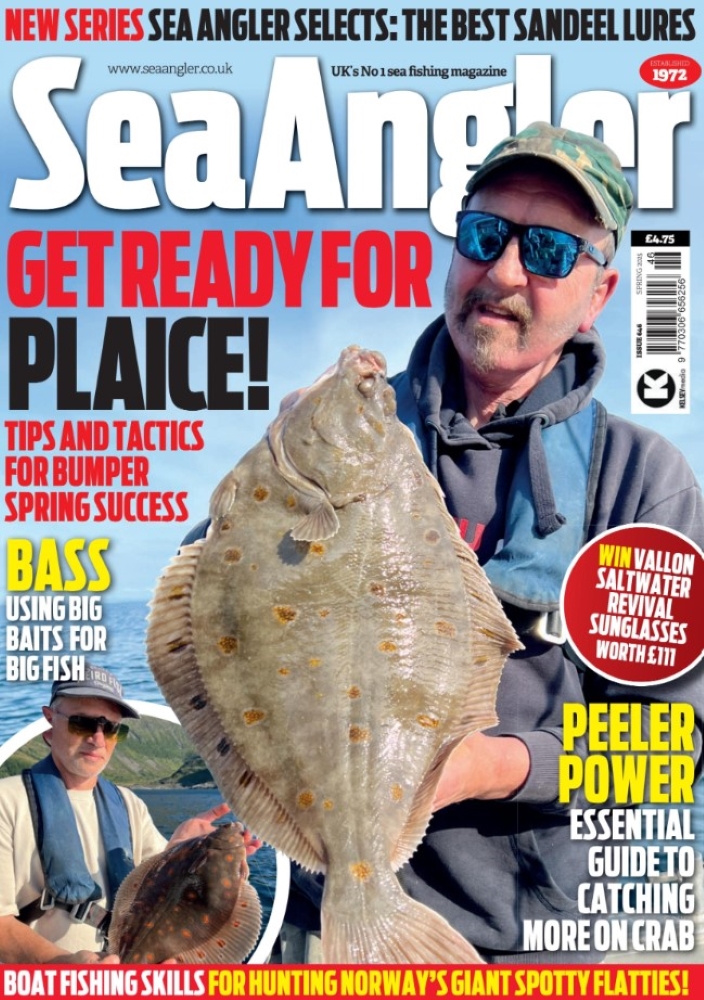Fish both high and low water at this mark on the Mersey
Words and photography by Jay Pickup & Richie Steel

Jay Pickup with a ray
A popular mark on the Wirral peninsula, Vale Park is particularly noted for its spring plaice fishing, but offers year-round fishing for a range of species. It has easy access and parking too.
Fishing is either over high tide from the long promenade, that separates the park from the river, or over low water from a sandy beach.
When fishing at low water, anglers must be aware that the gully across the beach will fill behind them as the tide rises. Aim to start leaving the venue one hour after low water. For those fishing on the promenade over high water, be aware it can get very busy with anglers, dog walkers and cyclists. Take care with your bait, baited hooks and during casting. During the summer the northern end of the beach at low can be restricted due to moored small boats.
SEASONAL SPECIES
At the start of the year catches are mainly whiting and dabs with the occasional codling. Fishing for codling can be good in the autumn and late winter as the fish move in an out of the Mersey.
March through to May are the noted months for plaice. It is during early spring when thornback rays appear in numbers and this is often one of the first marks on the Mersey to produce them consistently. The rays remain until to end of the year.
In early summer, an occasional smoothhound starts to show in catches as the fish move in from Liverpool Bay. These are typically replaced by dogfish for a few weeks at the end of the summer. Thick-lipped mullet can be caught in the summer around the rock groynes at the ends of this venue.
Whiting appear from the end of September and can be present in large numbers, making it sometimes difficult to get a bait past them and the resident dabs to target larger fish.
TACTICS

Richie Fisher with a ray
The mark is bounded by large rock groynes to its north (known as the Pirate Ship groyne) and southern ends. Popular areas for fishing are directly in front of the park entrance at high water or in front of a double slipway area at low water, although anywhere along the stretch can produce fish.
At high water, mixed ground and small rocky outcrops give way to clean sand. A gully runs the length of the beach between the groynes, which provides a target to cast to at around 50 to 80 metres. The depth of this feature appears to have reduced in recent years. Low water fishing provides access to deeper water within the river channel where the ground is mixture of sand, bedrock and mussel beds. It can be snaggy in places but relocating a short distance usually solves this problem.
Over high water the strong tidal flows are reduced by the groynes, which allows the mark to be fished even on very large tides when thornbacks venture from the river channel and appear in promenade catches.
Fishing is typically three hours up to high water and two hours into the ebb with the peak of activity often g 90 minutes either side of high water. Low water fishing is typically three hours down and one hour into the flood and best on mid-range tides when high water is around eight to eight and a half metres.
Plaice fishing can be brisk at the start of the flood. Casting at distance produces better results for winter codling. On larger tides, the flow is very strong making for challenging fishing and the likelihood of tackle settling into snags. It often pays to get out fishing at low water, by wading through shallow water, as soon as the sandbar starts to appear, with rays, codling and smoothhounds often caught during the first few casts and a further peak time around an. hour either side of low water.
TACKLE
Standard beach tackle will suffice. However, there is a need to account for the strong flows when fishing low water. Anglers should allow plenty of room between themselves, cast upstream and allow some slack line for grip leads to find a hold on the sandy bottom. The starting point is normally a six-ounce grip lead, although this may need to be increase to seven ounces on bigger tides. Smaller leads can be used by those fishing over high water.
For plaice, whiting and dabs, flapper or wishbone rigs are effective. Given the turbid waters of the Mersey the use of ‘bling’ on rigs offers little benefit. For rays and other species, standard pulley rigs, pulley dropper or loop rigs are effective.
Plaice, whiting and dabs all fall to worm baits. Tipping worm baits with squid or fish attracts more whiting. Worm and squid combinations or peeler crab are effective for the codling, and together with bluey, sand eel or mackerel and squid combinations produce the rays.

NEED TO KNOW
Getting there
Leave junction 1 of the M53 and follow the A554 to New Brighton. Drive along the promenade and to the roundabout at the Marine Point Retail Park. Turn right to keep on the A554 and head up the hill. Turn into Magazine Lane and follow this down until the old gate structure of the Magazine and turn left into a cobbled road. Free parking is available here and allows easy access to the promenade and also to the beach via the double slipway.
Tackle shop
Bonners Bait ‘N’ Tackle, 114 Victoria Rd, New Brighton, CH45 2JF, tel: : 0151 638 0883.
Shack Bait and Tackle, Leasowe Road, Wirral, CH46 2RH, tel: 07572 927 128.
Fisherman Tackle and Bait, 179 Laird St, Birkenhead, CH41 0AA, tel: tel: 0151 653 4070.







